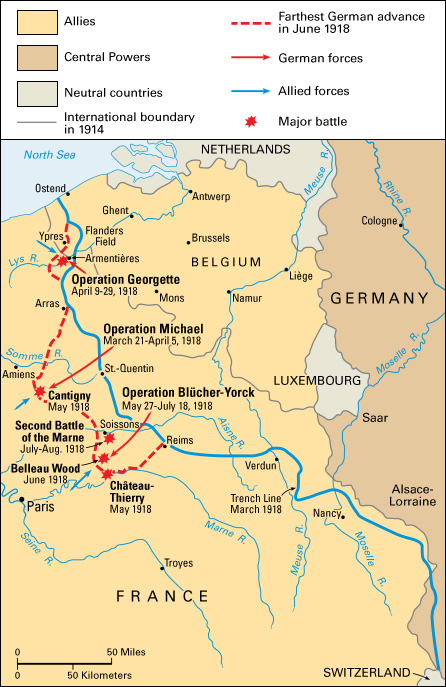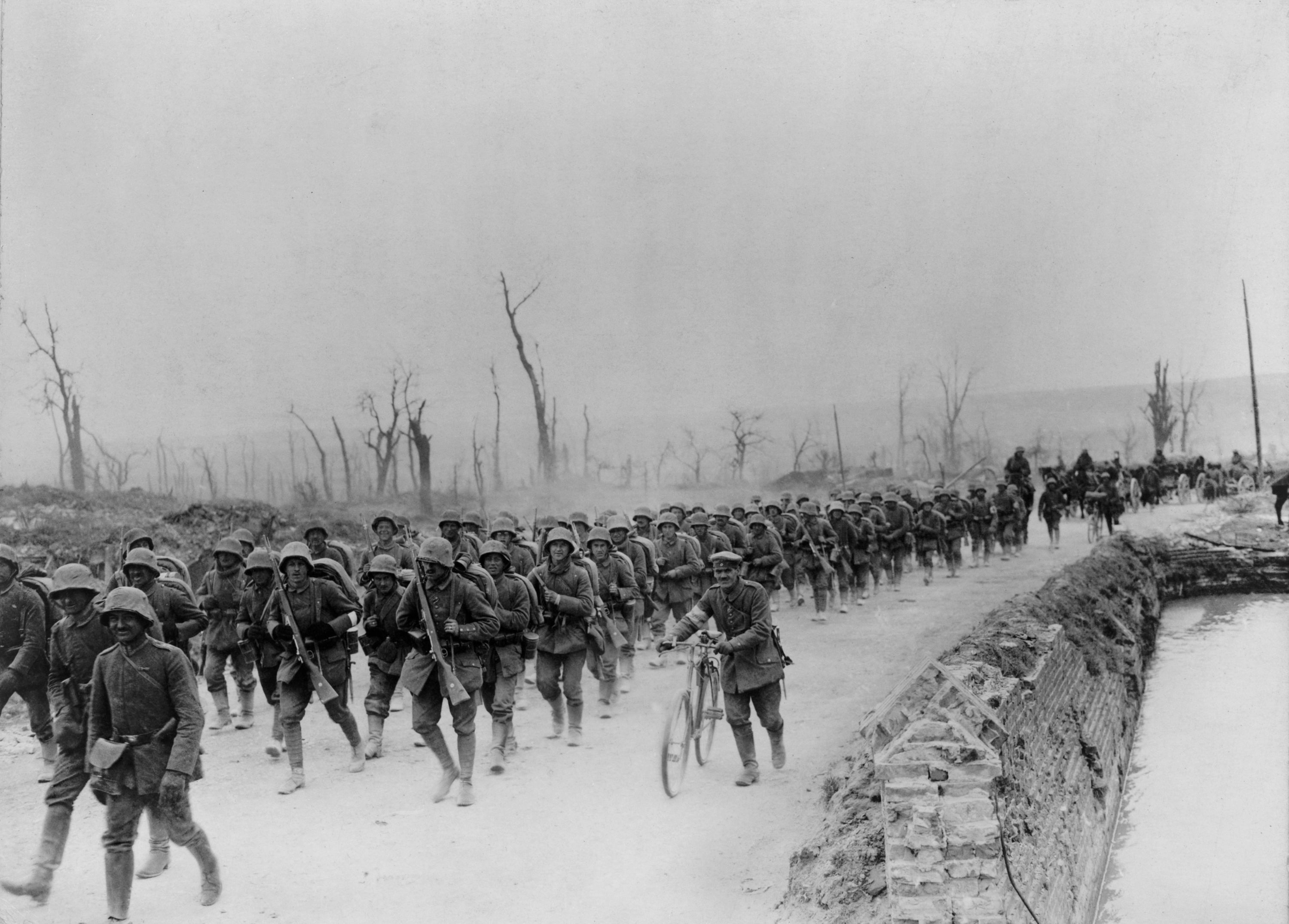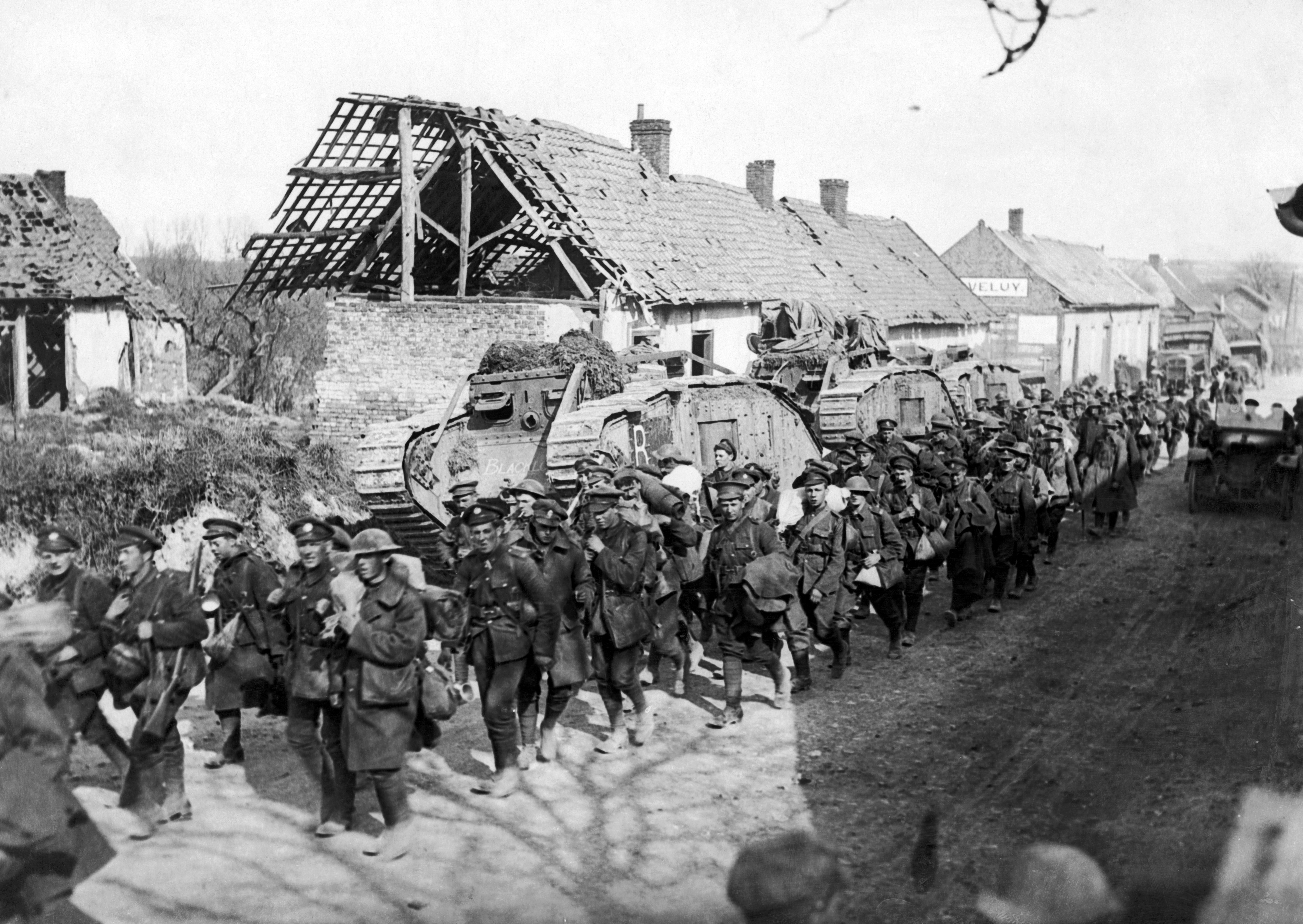German Spring Offensive was a series of German assaults on Allied forces late in World War I (1914-1918). The assaults took place from March to July 1918 along the Western Front, the battlefront that stretched through Belgium and northern France . The German assaults broke the Allied lines and ended the stalemate of trench warfare (fighting from fortified ditches). The offensive gained much territory, but it failed to achieve German victory. It also exhausted the German army, setting the stage for Allied counterattacks and an ultimate Allied victory in World War I.

The German Spring Offensive is also known as the Ludendorff Offensive, after German General Erich Ludendorff . In Germany , the offensive is called the Kaiserschlacht, or Kaiser’s Battle. Kaiser was the title used by rulers of the German Empire.
Background.
For most of World War I, the strength of the German military was split. Fighting against the British and French on the Western Front required millions of German troops. At the same time, German forces were needed to battle Russian, and later Romanian, forces on the Eastern Front. The Eastern Front would eventually stretch from Estonia to Romania.
By December 1917, both Russia and Romania were defeated and nearing surrender. The end of fighting on the Eastern Front then allowed Germany to concentrate its military on the West. For the first time, German forces would outnumber the Allies on the Western Front.
The Germans needed to take advantage of their numbers in early 1918. By that time, the United States had entered the war on the Allied side, but the majority of U.S. forces had not yet reached Europe. The Germans planned a huge offensive that sought to force an Allied surrender before U.S. troops could arrive in force.

Planning the offensive.
The British army had been exhausted by massive, costly battles in 1916 and 1917. General Ludendorff, the German army’s chief of staff, thus planned a series of assaults that would target British-held parts of the Western Front.
The main German assault, called Operation Michael, would hit first. It would move along the Somme River in northern France. The second assault, Operation Georgette, would come in Flanders , on France’s border with Belgium. A third assault, Operation Blücher-Yorck, would hit French positions along the Aisne River . The Aisne assault was intended to divert Allied reserves away from Flanders, where a final attack, Operation Hagen, would destroy the British army. According to the plan, France would seek to negotiate a peace once the British were eliminated.
The great majority of Allied troops facing the Germans were British and French. However, many thousands of Australian, Belgian, Canadian, Italian, New Zealander, Portuguese, South African, and U.S. troops fought as well.
Operation Michael.
On March 21, 1918, German troops struck fiercely along a 60-mile (100-kilometer) front centered on the French city of Saint-Quentin. The invading force used such weapons as artillery and poison gas. It also used new infantry tactics that had succeeded on the Eastern and Italian fronts. The British line soon collapsed. 
Thousands of British troops became trapped as German infantry raced deep into Allied territory. German troops advanced about 40 miles (65 kilometers). However, dwindling supplies and war-ravaged terrain slowed the advance. British and French reserves eventually halted the Germans, and Ludendorff ended the offensive on April 5. The opening of the German assault was such a success that Kaiser Wilhelm II, Germany’s ruler, declared a national holiday.
Allied and German casualties (people killed, wounded, missing, or captured) in Operation Michael amounted to about 250,000 each. Following the assault, French General Ferdinand Foch was appointed commander-in-chief of the Allied forces. Allied leaders hoped to improve the coordination between British and French units.
Operation Georgette.
On April 9, the Germans attacked near Armentières, south of the Belgian border. The next day, they hit Allied positions north of the border near Ypres (also spelled Ieper). Both attacks broke through the Allied lines, and German troops quickly crossed the Lys River. The Germans gained about 9 miles (15 kilometers) before their advance slowed. Renewing the attack in late April, they managed to take Mount Kemmel despite strong resistance. The offensive continued, with little further advance, until Ludendorff called it off on April 29. Operation Georgette—often called the Battle of the Lys—cost both sides more than 100,000 casualties.
Operation Blücher-Yorck.
On May 27, German troops attacked Allied positions along the Aisne River between Soissons and Reims . The Allied line consisted of French troops and a number of British troops who had been sent there to rest from the fighting in Flanders.
The Allied line collapsed during the assault, and the Germans advanced about 30 miles (50 kilometers) to the Marne River northeast of Paris . German attacks, including two brief additional offensives nearby, continued throughout June and into July. A number of German units crossed the Marne as Allied aircraft and artillery battered German supply lines. The start of a massive Allied counterattack finally ended the German advance on July 18. Ludendorff then postponed the final Flanders assault, Operation Hagen.
The American Expeditionary Forces ( A.E.F. ), the U.S. army in Europe, played a significant role in halting Operation Blücher-Yorck. It staged successful, but costly, counterattacks at Château-Thierry and Belleau Wood in June. About 1 million U.S. troops were in France by July.
Some historians call Operation Blücher-Yorck the Third Battle of the Aisne and refer to the fighting from mid-July into early August as the Second Battle of the Marne . The offensive operations from May 27 to July 18 cost the Germans another 150,000 casualties and the Allies over 200,000. Operation Hagen was never launched.
Aftermath.
The German Spring Offensive made startling gains, but it failed to destroy the British army. It also failed to capture important Allied locations. The offensive took a heavy toll on the German army, with more than 500,000 casualties. Having used up its reserves from the Eastern Front, Germany could no longer replace such huge numbers of troops. The casualties and lack of overall success badly damaged German morale.
Allied casualties also reached 500,000. However, by the offensive’s end, U.S. troops were pouring into France at a rate of more than 250,000 each month. Massive Allied assaults began in August and continued until Germany signed an armistice (agreement to stop fighting) in November. The agreement brought an end to World War I.
